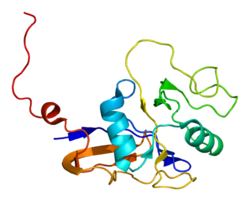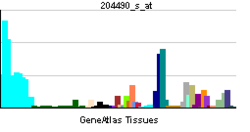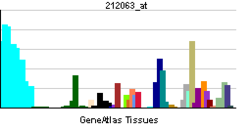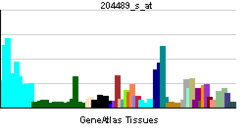CD44
| A+医学百科 >> CD44 |
CD44抗原为细胞表面的一种糖蛋白参与了细胞 - 细胞相互作用、细胞黏附和细胞迁移。在人类中,CD44抗原自第11号染色体上.[1] 的CD44 基因转录出。CD44亦被称为HCAM(homing cell adhesion molecule) (归巢细胞黏附分子),PGP-1(phagocytic glycoprotein-1)(吞噬糖蛋白-1),爱马仕抗原(Hermes antigen),淋巴细胞归巢受体(lymphocyte homing receptor),ECM-III和HUTCH-1。
目录 |
组织分布和异构体
CD44表现在大量的哺乳动物细胞。标准异构体:CD44s,含有外显子1-5和16-20会表现在大多数细胞类型。含可变外显子的CD44剪接变体:CD44V。还有一些上皮细胞会表达结构较大的异构体(CD44E),其中包括外显子V8-10。.[2]
功能
CD44其中一种受体为透明质酸(hyaluronic acid),也可以与其它受质,如骨桥蛋白(osteopontin),胶原蛋白,和基质金属蛋白酶(matrix metalloproteinases,MMPs)进行交互作用。而CD44的功能是由其转译后修饰来调控。其中一个重要的修饰包括对CD44的独立唾液酸化的岩藻糖基化(Sialylated,fucosylated)而这种呈现于CD44的选择素(selectin)结合糖型称为HCELL(为造血细胞E-selectin/L-selectin配位体)。HCELL糖型最初发现于人类造血干细胞和白血病细胞,[3][4][5][6],并随后用于鉴定癌细胞上.[7][8][9][10][11]。HCELL作为“骨质归巢受体”(bone homing receptor)引导人类造血干细胞和间叶干细胞(mesenchymal stem cells)迁移到骨髓.[5]。体外活体细胞表面聚糖工程已用于强制HCELL的表现于会表现出的CD44的任何细胞.[12]。CD44的糖基化也直接控制其对于纤维蛋白的结合和纤维蛋白原的固定能力.[13][14]
CD44这种蛋白参与了多种细胞功能,包括淋巴细胞的活化、再循环和归位(homing),血细胞生成和肿瘤转移。基因发生复杂的选择性剪接会产生不同种功能不同的亚型;然而,其中一些亚型的性质尚未确定。选择性剪接改变蛋白质的结构与功能性,可能与肿瘤转移有关。利用血液动力学也发现在直肠癌细胞中表现出的CD44亚型表面有独立唾液酸化的岩藻糖基化(HCELL)的糖型修饰会与P-, L-, 和E型选择素还有纤维蛋白进行结合(纤维蛋白原则不会结合),而与选择素的结合也意味着肿瘤转移的可能性。CD44转录的活化部分会借由β-联蛋白以及Wnt信号传导进行,而这也跟肿瘤发展有所关联。
临床意义
该蛋白是一个决定检体是否为印度血型(Indian blood group system)的一种因素
- CD44与CD25,用于在胸腺追踪早期T细胞的发展。
- CD44的表达是一个指示标记效应记忆T细胞(effector-memory T-cells)。记忆细胞增殖(活化)也可在体外用CFSE(Carboxyfluorescein succinimidyl ester)化学标记进行检测。
此外,不同的CD44被发现为可以用于某些乳腺癌(breast cancer)和前列腺癌(prostate cancer)干细胞的细胞表面标记。在乳腺癌研究CD44 + / CD24-表达的有无通常被作为乳房肿瘤干细胞的确认并由此为依据于将该种乳腺癌细胞分类成富含干细胞特性的群体。此种蛋白表现也一直被视为在上皮性卵巢癌(epithelial ovarian cancer)患者提高生存时间的指标。
子宫内膜细胞在子宫内膜异位症(endometriosis demonstrate)会增加的CD44剪接变异体的表现量,并提高对腹腔细胞的附着力。
CD44的变异亚型也与头颈部鳞状细胞癌(ead and neck squamous cell carcinoma)的发展有关。
在临床上会利用Bivatuzumab(一种人类的单株抗体)来检测CD44 v6(其中一种CD44剪接变异体)
与CD44交互作用的物质
CD44会与下列物质进行蛋白质-蛋白质交互作用:
更进一步了解
- Sackstein R. Glycosyltransferase-programmed stereosubstitution to create HCELL: Engineering a Roadmap for Cell Migration. Immunological Reviews. July 2009, 230 (1): 51–74. doi:10.1111/j.1600-065X.2009.00792.x. PMID 19594629.
- Sackstein R. The bone marrow is akin to skin: HCELL and the biology of hematopoietic stem cell homing. J. Invest. Dermatol.. May 2004, 122 (5): 1061–9. doi:10.1111/j.0022-202X.2004.09301.x. PMID 15140204.
- Konstantopoulos K, Thomas SN. Cancer cells in transit: the vascular interactions of tumor cells. Annu Rev Biomed Eng. 2009, 11: 177–202. doi:10.1146/annurev-bioeng-061008-124949. PMID 19413512.
- Günthert U. CD44: a multitude of isoforms with diverse functions. Curr. Top. Microbiol. Immunol.. 1994, 184: 47–63. doi:10.1007/978-3-642-78253-4_4. PMID 7508842.
- Yasuda M, Nakano K, Yasumoto K, Tanaka Y. CD44: functional relevance to inflammation and malignancy. Histol. Histopathol.. 2003, 17 (3): 945–50. PMID 12168806.
- Sun CX, Robb VA, Gutmann DH. Protein 4.1 tumor suppressors: getting a FERM grip on growth regulation. J. Cell. Sci.. 2003, 115 (Pt 21): 3991–4000. doi:10.1242/jcs.00094. PMID 12356905.
- Ponta H, Sherman L, Herrlich PA. CD44: from adhesion molecules to signalling regulators. Nature Reviews Molecular Cell Biology. 2003, 4 (1): 33–45. doi:10.1038/nrm1004. PMID 12511867.
- Martin TA, Harrison G, Mansel RE, Jiang WG. The role of the CD44/ezrin complex in cancer metastasis. Crit. Rev. Oncol. Hematol.. 2004, 46 (2): 165–86. doi:10.1016/S1040-8428(02)00172-5. PMID 12711360.
参考文献
- ↑ Spring FA, Dalchau R, Daniels GL, Mallinson G, Judson PA, Parsons SF, Fabre JW, Anstee DJ. [http//www.ncbi.nlm.nih.gov/pmc/articles/PMC1385183/ The Ina and Inb blood group antigens are located on a glycoprotein of 80,000 MW (the CDw44 glycoprotein) whose expression is influenced by the In(Lu) gene]. Immunology. May 1988, 64 (1): 37–43. PMID 2454887. PMC 1385183.
- ↑ Goodison S, Urquidi V, Tarin D. [http//www.ncbi.nlm.nih.gov/pmc/articles/PMC395698/ CD44 cell adhesion molecules]. MP, Mol. Pathol.. August 1999, 52 (4): 189–96. doi:10.1136/mp.52.4.189. PMID 10694938. PMC 395698.
- ↑ Oxley SM, Sackstein R. Detection of an L-selectin ligand on a hematopoietic progenitor cell line. Blood. November 1994, 84 (10): 3299–306. PMID 7524735.
- ↑ Sackstein R, Dimitroff CJ. A hematopoietic cell L-selectin ligand that is distinct from PSGL-1 and displays N-glycan-dependent binding activity. Blood. October 2000, 96 (8): 2765–74. PMID 11023510.
- ↑ 5.0 5.1 Sackstein R, Merzaban JS, Cain DW, Dagia NM, Spencer JA, Lin CP, Wohlgemuth R. Ex vivo glycan engineering of CD44 programs human multipotent mesenchymal stromal cell trafficking to bone. Nat. Med.. February 2008, 14 (2): 181–7. doi:10.1038/nm1703. PMID 18193058.
- ↑ Dimitroff CJ, Lee JY, Rafii S, Fuhlbrigge RC, Sackstein R. [http//www.ncbi.nlm.nih.gov/pmc/articles/PMC2192031/ Cd44 Is a Major E-Selectin Ligand on Human Hematopoietic Progenitor Cells]. J. Cell Biol.. June 2001, 153 (6): 1277–86. doi:10.1083/jcb.153.6.1277. PMID 11402070. PMC 2192031.
- ↑ Hanley WD, Burdick MM, Konstantopoulos K, Sackstein R. CD44 on LS174T colon carcinoma cells possesses E-selectin ligand activity. Cancer Res.. July 2005, 65 (13): 5812–7. doi:10.1158/0008-5472.CAN-04-4557. PMID 15994957.
- ↑ Burdick MM, Chu JT, Godar S, Sackstein R. HCELL is the major E- and L-selectin ligand expressed on LS174T colon carcinoma cells. J. Biol. Chem.. May 2006, 281 (20): 13899–905. doi:10.1074/jbc.M513617200. PMID 16565092.
- ↑ 9.0 9.1 Hanley WD, Napier SL, Burdick MM, Schnaar RL, Sackstein R, Konstantopoulos K.. Variant isoforms of CD44 are P- and L-selectin ligands on colon carcinoma cells. FASEB J. Dec 2005, 20 (2): 337–9. doi:10.1096/fj.05-4574fje. PMID 16352650.
- ↑ 10.0 10.1 Napier SL, Healy ZR, Schnaar RL, Konstantopoulos K. Selectin ligand expression regulates the initial vascular interactions of colon carcinoma cells: the roles of CD44v and alternative sialofucosylated selectin ligands. J Biol Chem. Feb 2007, 282 (6): 3433–41. doi:10.1074/jbc.M607219200. PMID 17135256.
- ↑ 11.0 11.1 Thomas SN, Zhu F, Schnaar RL, Alves CS, Konstantopoulos K. [http//www.ncbi.nlm.nih.gov/pmc/articles/PMC2414264/ Carcinoembryonic Antigen and CD44 Variant Isoforms Cooperate to Mediate Colon Carcinoma Cell Adhesion to E- and L-selectin in Shear Flow]. J Biol Chem. Jun 2008, 283 (23): 15647–55. doi:10.1074/jbc.M800543200. PMID 18375392. PMC 2414264.
- ↑ Sackstein R. Glycosyltransferase-programmed stereosubstitution (GPS) to create HCELL: engineering a roadmap for cell migration. Immunol. Rev.. July 2009, 230 (1): 51–74. doi:10.1111/j.1600-065X.2009.00792.x. PMID 19594629.
- ↑ 13.0 13.1 Alves CS, Burdick MM, Thomas SN, Pawar P, Konstantopoulos K. The dual role of CD44 as a functional P-selectin ligand and fibrin receptor in colon carcinoma cell adhesion. Am J Physiol Cell Physiol. Apr 2008, 294 (4): C907–16. doi:10.1152/ajpcell.00463.2007. PMID 18234849.
- ↑ 14.0 14.1 Alves CS, Yakovlev S, Medved L, Konstantopoulos K. [http//www.ncbi.nlm.nih.gov/pmc/articles/PMC2613610/ Biomolecular Characterization of CD44-Fibrin(ogen) Binding: DISTINCT MOLECULAR REQUIREMENTS MEDIATE BINDING OF STANDARD AND VARIANT ISOFORMS OF CD44 TO IMMOBILIZED FIBRIN(OGEN)]. J Biol Chem. Jan 2009, 284 (2): 1177–89. doi:10.1074/jbc.M805144200. PMID 19004834. PMC 2613610.
- ↑ Bourguignon LY, Singleton PA, Zhu H, Diedrich F. Hyaluronan-mediated CD44 interaction with RhoGEF and Rho kinase promotes Grb2-associated binder-1 phosphorylation and phosphatidylinositol 3-kinase signaling leading to cytokine (macrophage-colony stimulating factor) production and breast tumor progression. J. Biol. Chem.. August 2003, 278 (32): 29420–34. doi:10.1074/jbc.M301885200. PMID 12748184.
- ↑ Zohar R, Suzuki N, Suzuki K, Arora P, Glogauer M, McCulloch CA, Sodek J. Intracellular osteopontin is an integral component of the CD44-ERM complex involved in cell migration. J Cell Physiol. July 2000, 184 (1): 118–130. doi:10.1002/(SICI)1097-4652(200007)184:1<118::AID-JCP13>3.0.CO;2-Y. PMID 10825241.
- ↑ Jalkanen S, Jalkanen M. [http//www.ncbi.nlm.nih.gov/pmc/articles/PMC2289325/ Lymphocyte CD44 binds the COOH-terminal heparin-binding domain of fibronectin]. J. Cell Biol.. February 1992, 116 (3): 817–25. doi:10.1083/jcb.116.3.817. PMID 1730778. PMC 2289325.
- ↑ 18.0 18.1 Ilangumaran S, Briol A, Hoessli DC. CD44 selectively associates with active Src family protein tyrosine kinases Lck and Fyn in glycosphingolipid-rich plasma membrane domains of human peripheral blood lymphocytes. Blood. May 1998, 91 (10): 3901–8. PMID 9573028.
- ↑ Taher TE, Smit L, Griffioen AW, Schilder-Tol EJ, Borst J, Pals ST. Signaling through CD44 is mediated by tyrosine kinases. Association with p56lck in T lymphocytes. J. Biol. Chem.. February 1996, 271 (5): 2863–7. doi:10.1074/jbc.271.5.2863. PMID 8576267.
- ↑ Bourguignon LY, Zhu H, Shao L, Chen YW. CD44 interaction with c-Src kinase promotes cortactin-mediated cytoskeleton function and hyaluronic acid-dependent ovarian tumor cell migration. J. Biol. Chem.. March 2001, 276 (10): 7327–36. doi:10.1074/jbc.M006498200. PMID 11084024.
- Sackstein, Robert. [http//www.ncbi.nlm.nih.gov/pmc/articles/PMC3145154/ The Biology of CD44 and HCELL in Hematopoiesis: The "Step 2-bypass Pathway" and other Emerging Perspectives]. Current Opinion in Hematology. July 2011, 18 (4): 239–248. doi:10.1097/MOH.0b013e3283476140. PMID 21546828. PMC 3145154.
外部链接
- Indian blood group system at BGMUT Blood Group Antigen Gene Mutation Database at NCBI, NIH
- Articles at IHOP.
|
|||||
|
|||||||||||||||||||||||
|
||||||||||||||||||||||||||||||
参考来源
| 关于“CD44”的留言: | |
|
目前暂无留言 | |
| 添加留言 | |



